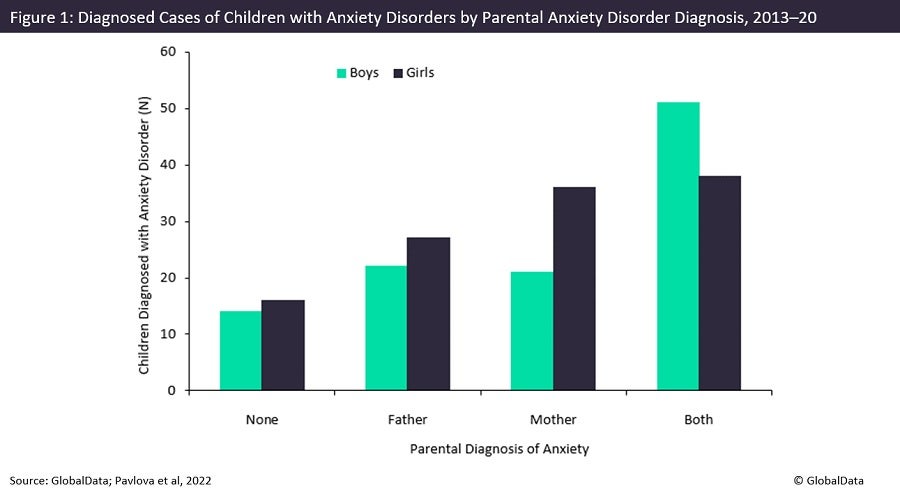Anxiety has become an eminent public health concern in recent years. Economic uncertainty and isolation introduced by the Covid-19 pandemic have fostered a growing number of individuals suffering from various forms of anxiety. Of particular concern is the prevalence of anxiety among children and adolescents, many of whom have been deprived of protective social support systems frequently provided by schools.
A recent publication in the Journal of the American Medical Association (JAMA) by Pavlova and colleagues has explored the impact of parents’ mental health diagnoses and biological sex on the transmission of anxiety disorders to their offspring. Its findings suggest that a diagnosis of anxiety, mood and psychotic disorders among parents in the same household are predictive factors behind their children’s odds of a lifetime anxiety disorder diagnosis, especially if they are of the same sex as the child. Across the 16 major pharmaceutical markets (16MM: US, France, Germany, Italy, Spain, UK, Japan, Australia, Brazil, Canada, China, India, Mexico, Russia, South Africa and South Korea), GlobalData epidemiologists expect a rise in cases of anxiety if clinicians further integrate parental sex and mental health history into juvenile anxiety screening.
The JAMA publication appears to be the first to explore the impact of both parental sex and mental health diagnosis on anxiety in their offspring. Its data are the product of a cross-sectional study known as the Families Overcoming Risks and Building Opportunities for Well-Being (FORBOW) project, which followed 398 offspring living in Nova Scotia, Canada, between 2013 and 2020. Among participating children, 27.1% had received at least one anxiety disorder. The most prevalent diagnoses in this category were generalised, social and separation anxiety. Males and females expressed anxiety at a similar frequency at 24.1% of boys compared to 30.1% of girls. There was, however, a correlation between anxiety prevalence and age; participants aged younger than nine years experienced anxiety at a prevalence of 14.1% compared with 51.8% in those aged older than 15 years.
The findings outlined the influence of parental mental health diagnosis on their offspring’s history of anxiety. Only 23.7% of children reported an anxiety diagnosis if both parents exhibited no anxiety, mood or psychotic disorders. This figure increased to 28.1% if one parent had one of these conditions and nearly doubled to 41.4% if both did. In addition, the prevalence of anxiety was highest among children of parents with bipolar disorder (36.0%) and lowest among the children of parents with schizophrenia (6.3%). Notably, the authors identified a significant trend in the transmission of anxiety between parents and children of the same sex. As can be observed in Figure 1, anxiety among mothers was a significant predictor of anxiety in their daughters, but not sons. This relationship was insignificant, however, when observing transmission from fathers to sons. Further to this, the presence of a parent without anxiety reduced the lifetime odds of an anxiety diagnosis in a child of the same sex.
Although anxiety is believed to be a product of both nature and nurture, the genetics driving its onset remain poorly understood. By drawing attention to a potential sex-linked pattern, the authors of the JAMA study may bolster the hypothesis of an X-linked mechanism. Their findings also contribute to a sizeable body of knowledge tying environment to anxiety disorder. If residing in the same household as the parents was linked to children’s diagnoses, inheritance cannot be the sole mechanism behind its onset.
These conclusions elicit avenues for further research into the roles of parenting, observational learning and gender roles in anxiety’s pathogenesis. From a clinical perspective, parental presence and mental health history should be taken into greater consideration when screening for anxiety disorders, especially among children.
How well do you really know your competitors?
Access the most comprehensive Company Profiles on the market, powered by GlobalData. Save hours of research. Gain competitive edge.

Thank you!
Your download email will arrive shortly
Not ready to buy yet? Download a free sample
We are confident about the unique quality of our Company Profiles. However, we want you to make the most beneficial decision for your business, so we offer a free sample that you can download by submitting the below form
By GlobalDataGlobalData epidemiologists forecast that the total prevalent cases of anxiety disorders (which include both diagnosed and undiagnosed cases) will increase between 2018 and 2028. Across the 16MM, women are expected to see a rise from 180.7 million cases this year to 186.1 million cases in 2028. Among men, the caseload is expected to increase from 110.9 million to 115 million cases during the same period. The findings of the present study establish a clearer picture of the risk profile for anxiety disorders, as well as improvements in screening and diagnosis. These changes in case identification would likely drive an increase in the caseloads originally projected in current forecasts.






Related Company Profiles
JAMA Sp. z o.o.